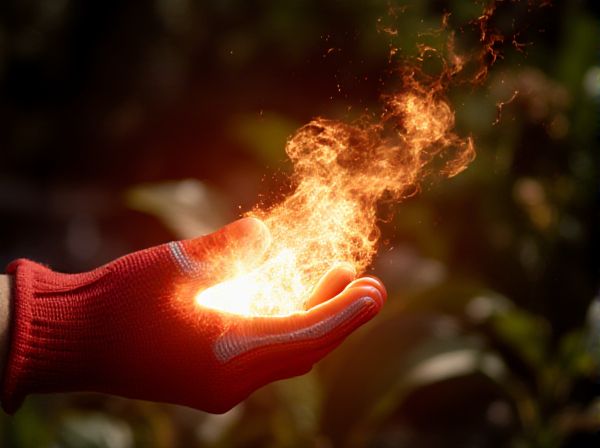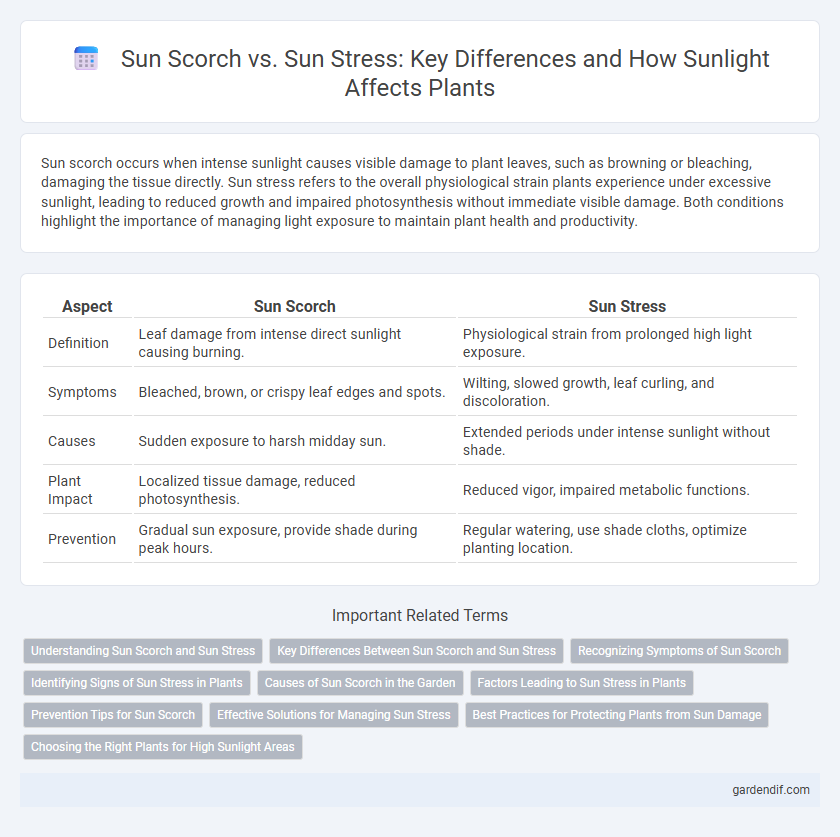
Sun Scorch vs Sun Stress Illustration
Sun scorch occurs when intense sunlight causes visible damage to plant leaves, such as browning or bleaching, damaging the tissue directly. Sun stress refers to the overall physiological strain plants experience under excessive sunlight, leading to reduced growth and impaired photosynthesis without immediate visible damage. Both conditions highlight the importance of managing light exposure to maintain plant health and productivity.
Table of Comparison
| Aspect | Sun Scorch | Sun Stress |
|---|---|---|
| Definition | Leaf damage from intense direct sunlight causing burning. | Physiological strain from prolonged high light exposure. |
| Symptoms | Bleached, brown, or crispy leaf edges and spots. | Wilting, slowed growth, leaf curling, and discoloration. |
| Causes | Sudden exposure to harsh midday sun. | Extended periods under intense sunlight without shade. |
| Plant Impact | Localized tissue damage, reduced photosynthesis. | Reduced vigor, impaired metabolic functions. |
| Prevention | Gradual sun exposure, provide shade during peak hours. | Regular watering, use shade cloths, optimize planting location. |
Understanding Sun Scorch and Sun Stress
Sun scorch refers to the physical damage on plant leaves caused by intense, direct sunlight, resulting in discoloration, browning, and tissue death. Sun stress encompasses a broader range of physiological responses in plants due to excessive solar radiation, including reduced photosynthesis, heat stress, and dehydration. Recognizing the symptoms of sun scorch and understanding the underlying mechanisms of sun stress are crucial for effective plant care and prevention strategies.
Key Differences Between Sun Scorch and Sun Stress
Sun scorch refers to the physical damage on plant leaves caused by intense direct sunlight, resulting in bleached, brown, or crispy patches often along leaf edges. Sun stress, however, encompasses a broader physiological response where excessive sunlight disrupts photosynthesis, leading to reduced growth, wilting, or increased susceptibility to diseases without visible leaf damage. Key differences include sun scorch's visible leaf injury versus sun stress's internal metabolic imbalance, with sun scorch being more acute and sun stress representing prolonged exposure effects.
Recognizing Symptoms of Sun Scorch
Sun scorch manifests as irregular brown or white patches on leaves, caused by intense sunlight damaging plant tissues. Recognizing symptoms includes leaf discoloration, curling edges, and dry, brittle texture, distinct from sun stress, which presents as overall wilt and faded color without tissue death. Early identification helps prevent irreversible damage by adjusting light exposure and providing adequate hydration.
Identifying Signs of Sun Stress in Plants
Sun stress in plants manifests through symptoms such as leaf discoloration, wilting, and reduced growth, which differ from the immediate tissue damage seen in sun scorch characterized by brown, crispy leaf edges. Identifying signs of sun stress includes observing pale, yellowed leaves, sunken spots, and drooping foliage indicating prolonged exposure to intense sunlight beyond plant tolerance. Monitoring these stress indicators helps distinguish sun stress from sun scorch, enabling targeted interventions like shading or adjusting watering schedules to promote plant health.
Causes of Sun Scorch in the Garden
Sun scorch in the garden occurs primarily due to prolonged exposure to intense sunlight, causing leaf tissue damage and browning. Factors such as sudden temperature fluctuations, inadequate watering, and lack of acclimatization to direct sun contribute to this condition. Unlike general sun stress, sun scorch manifests as specific damage to plant leaves, often exacerbated by environmental conditions like wind and low humidity.
Factors Leading to Sun Stress in Plants
Sun stress in plants primarily arises from excessive light intensity combined with high temperatures, leading to the disruption of photosynthesis and metabolic processes. Other critical factors include water deficiency, nutrient imbalances, and poor air circulation, which exacerbate cellular damage and oxidative stress. Prolonged exposure to ultraviolet radiation and inadequate acclimation to sudden changes in sunlight intensity further intensify the plant's physiological strain.
Prevention Tips for Sun Scorch
Sun scorch occurs when plants receive excessive direct sunlight, leading to leaf discoloration and tissue damage, whereas sun stress is a broader condition involving heat and light intensity affecting plant metabolism. To prevent sun scorch, apply shade cloths during peak sunlight hours, ensure consistent watering to maintain soil moisture, and select sun-tolerant plant varieties. Mulching around plants also helps regulate soil temperature and reduces the risk of sun-related damage.
Effective Solutions for Managing Sun Stress
Sun scorch manifests as visible leaf damage and tissue browning caused by excessive sunlight, whereas sun stress refers to the overall physiological strain plants endure under intense solar exposure. Effective solutions for managing sun stress include implementing shade covers, optimizing irrigation to maintain adequate soil moisture, and selecting heat-tolerant plant varieties. Employing these strategies helps reduce photoinhibition, prevent cellular damage, and promote plant resilience in high sunlight conditions.
Best Practices for Protecting Plants from Sun Damage
Sun scorch appears as bleached, crispy leaf edges caused by intense sunlight exposure, while sun stress triggers metabolic imbalances reducing growth and vigor. To protect plants, apply shade cloths during peak sunlight hours, increase watering to maintain soil moisture, and use organic mulches to regulate root temperature. Selecting sun-tolerant plant varieties and positioning sensitive species away from direct afternoon sun further minimizes the risk of sun damage.
Choosing the Right Plants for High Sunlight Areas
Sun scorch occurs when plant leaves suffer direct damage from intense sunlight, resulting in bleached or brown patches, while sun stress refers to the overall physiological strain caused by prolonged exposure to high light intensity and heat. Selecting drought-tolerant, sun-loving plants such as succulents, lavender, and ornamental grasses helps prevent damage by promoting resilience under full sun conditions. Incorporating native species adapted to local sunlight and temperature extremes ensures optimal growth and reduces the risk of sun-related damage in high sunlight areas.
Sun Scorch vs Sun Stress Infographic

 gardendif.com
gardendif.com